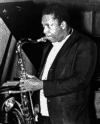
Coltrane, John
in full John William Coltrane(born Sept. 23, 1926, Hamlet, N.C., U.S.—died July 17, 1967, Huntington, N.Y.) American jazz saxophonist, bandleader, and composer who exerted an influence on the jazz of the 1960s and '70s that was at least as strong as Charlie Parker's had been in the 1940s and '50s.
After growing up in Philadelphia, Coltrane worked with Eddie Vinson, Dizzy Gillespie, Earl Bostic, and Johnny Hodges and then came to wide attention by recording with Miles Davis intermittently from 1955 to 1960 and briefly with Thelonious Monk in 1957. During those years Coltrane's tone on the tenor saxophone was huge and dark, with clear definition and full body, even in the high register and with the split-note multiphonics that became his trademark. The cascade of notes during his powerful solos showed his infatuation with chord progressions, culminating in the virtuoso performance of his difficult “Giant Steps.”
In the early 1960s Coltrane focused on mode-based improvisation in which solos were played atop one- or two-note accompanying figures that were repeated for extended periods of time (typified in his recordings of the Rodgers and Hammerstein “My Favorite Things”). From 1960 to 1965 he performed with his own highly acclaimed quartet, featuring drummer Elvin Jones, pianist McCoy Tyner, and bassist Jimmy Garrison. At the same time, his study of the native musics of India and Africa was ultimately expressed on the instrument Coltrane popularized—the soprano saxophone. These influences, combined with a unique interplay with the drums and the steady vamping of the piano and bass, made the Coltrane quartet among the most influential combos of the 1960s.
The short period between 1965 and Coltrane's death saw the dissolution of his quartet, but it also marked the expansion in his work of a free, collective improvisation based on prearranged scales clustered around tonal centres. Coltrane's wife Alice (also a jazz musician and composer) played the piano in his band during the last years of his life. This period is best represented in his albums Ascension and Meditations.
Copyright © 1994-2005 Encyclopædia Britannica, Inc.

